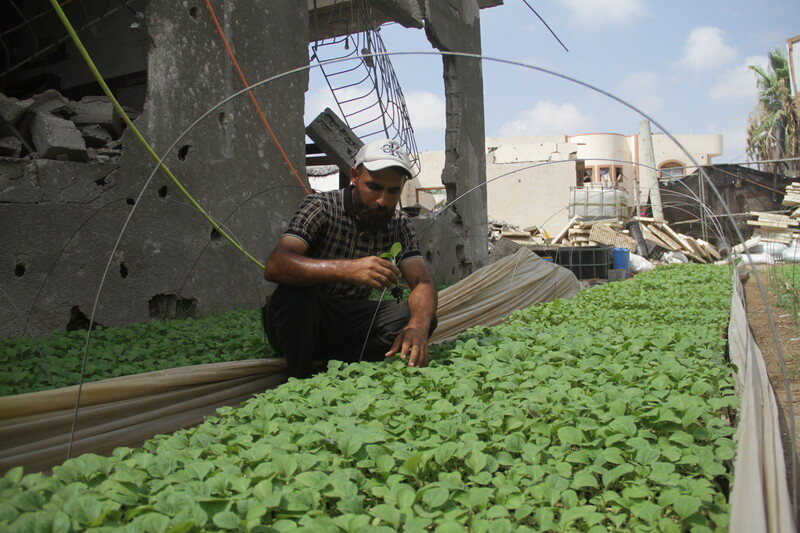The Electronic Intifada 1 October 2024

A man tends his rooftop farm in Beit Lahia, northern Gaza on 25 July. Farmers in Gaza have had to improvise to stave off the constant threat of famine.
XinhuaMuhammad Abu Samra is one of many people in his family who makes their living from farming.
Not any more. The farmland Abu Samra owns and cultivates on the eastern edge of Deir al-Balah in the central Gaza Strip was bombed repeatedly over the past year and is now unusable for cultivation, he told The Electronic Intifada.
It’s deliberate, he said.
“The occupation wants to destroy houses, farms, streets and all elements of life in Gaza, not only to make us poor but also to make us dependent on aid and to leave us, in the post-aggression phase, as beggars.”
The pattern of damage in Gaza would seem to bear him out. According to satellite data analyzed by Al Jazeera, some 60 percent of Gaza’s agricultural land had been damaged or destroyed in the eight months from October 2023 to end of June.
Since then, the destruction has only continued. And the lack of care and cultivation has exacerbated the situation to the point where the UN estimates that 68 percent of Gaza’s permanent cropland exhibited “significant decline in health and density” by September.
Abu Samra, who now has to wait for aid from organizations such as the World Food Program in order to eat, used to sell vegetables to markets throughout the Gaza Strip.
Even in the best of times, making a living was a challenge, he said, pointing to the 17-year blockade on Gaza before last October that saw Israel set tight restrictions on what and could not enter the occupied territory.
“The blockade prevented the development of farms and even the development of irrigation canals due to the lack of equipment,” Abu Samra said.
Determined to starve Gaza
Nevertheless, before the genocide, there were some thriving agricultural lands in the eastern areas of the Gaza Strip.
Riad al-Mosdar and his family were vegetable farmers outside Jabaliya in the northern Gaza Strip. He used to sell his produce at a local market, which, he told The Electronic Intifada, was destroyed at the end of July.
He has no seeds and no equipment to cultivate land that he can any way no longer access. And even if he did, the economy has collapsed.
“We lost everything after 30 years as a farmer,” he said. “Today, I have become poorer. Everyone has become poorer. No one has food.”
Muhammad Abu Odeh of the Ministry of Agriculture in the Gaza Strip said Israel had deliberately destroyed Gaza’s agriculture sector with direct aerial bombardment of the land or by bulldozing it using heavy machinery and tanks.
“The occupation forces have prevented the entry of agricultural equipment, seeds, fertilizers and pesticides into the Gaza Strip since the beginning of the aggression,” Abu Odeh told The Electronic Intifada.
“They are determined to starve the population and prevent any effort to revive the agricultural sector,” he added.
With the harvest season for olives and dates coming up in October, this year’s agricultural production is a bust. And should Israel continue to prevent agricultural products and equipment from entering, it will deepen a food crisis in the territory that the UN has already described as a “starvation campaign.”
Abdullah Obaid owned a large farm in the village of al-Zawayda, also in the central Gaza Strip but not near the boundary with Israel. Due to the lack of grain available in the market, he stopped working five months ago. In August, he allowed tents to be erected on his land to shelter the displaced.
“We opened our lands to the displaced because there is no glimmer of hope,” he said.
Amjad Ayman Yaghi is a journalist based in Gaza.





